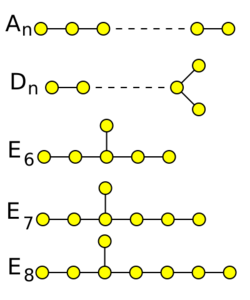du Val singularity
In algebraic geometry, a Du Val singularity, also called simple surface singularity, Kleinian singularity, or rational double point, is an isolated singularity of a complex surface which is modeled on a double branched cover of the plane, with minimal resolution obtained by replacing the singular point with a tree of smooth rational curves, with intersection pattern dual to a Dynkin diagram of A-D-E singularity type. They are the canonical singularities (or, equivalently, rational Gorenstein singularities) in dimension 2. They were studied by Patrick du Val[1][2][3] and Felix Klein.
The Du Val singularities also appear as quotients of [math]\displaystyle{ \Complex^2 }[/math] by a finite subgroup of SL2[math]\displaystyle{ (\Complex) }[/math]; equivalently, a finite subgroup of SU(2), which are known as binary polyhedral groups.[4] The rings of invariant polynomials of these finite group actions were computed by Klein, and are essentially the coordinate rings of the singularities; this is a classic result in invariant theory.[5][6]
Classification

The possible Du Val singularities are (up to analytical isomorphism):
- [math]\displaystyle{ A_n: \quad w^2+x^2+y^{n+1}=0 }[/math]
- [math]\displaystyle{ D_n: \quad w^2+y(x^2+y^{n-2}) = 0 \qquad (n\ge 4) }[/math]
- [math]\displaystyle{ E_6: \quad w^2+x^3+y^4=0 }[/math]
- [math]\displaystyle{ E_7: \quad w^2+x(x^2+y^3)=0 }[/math]
- [math]\displaystyle{ E_8: \quad w^2+x^3+y^5=0. }[/math]
See also
References
- ↑ du Val, Patrick (1934a). "On isolated singularities of surfaces which do not affect the conditions of adjunction, Entry I". Proceedings of the Cambridge Philosophical Society 30 (4): 453–459. doi:10.1017/S030500410001269X. https://www.zentralblatt-math.org/zmath/en/advanced/?q=an:0010.17602.
- ↑ du Val, Patrick (1934b). "On isolated singularities of surfaces which do not affect the conditions of adjunction, Entry II". Proceedings of the Cambridge Philosophical Society 30 (4): 460–465. doi:10.1017/S0305004100012706. https://www.zentralblatt-math.org/zmath/en/advanced/?q=an:0010.17603.
- ↑ du Val, Patrick (1934c). "On isolated singularities of surfaces which do not affect the conditions of adjunction, Entry III". Proceedings of the Cambridge Philosophical Society 30 (4): 483–491. doi:10.1017/S030500410001272X. http://www.zentralblatt-math.org/zmath/en/advanced/?q=an:0010.17701.
- ↑ Barth, Wolf P.; Hulek, Klaus; Peters, Chris A.M.; Van de Ven, Antonius (2004). Compact Complex Surfaces. Ergebnisse der Mathematik und ihre Grenzbereiche. 3. Teil (Results of mathematics and their border areas. 3rd Part). 4. Springer-Verlag, Berlin. pp. 197–200. ISBN 978-3-540-00832-3. OCLC 642357691. https://books.google.com/books?id=LtWDVZxiK6EC. Retrieved 2022-05-09.
- ↑ Artin, Michael (1966). "On isolated rational singularities of surfaces". American Journal of Mathematics 88 (1): 129–136. doi:10.2307/2373050. ISSN 0002-9327.
- ↑ Durfee, Alan H. (1979). "Fifteen characterizations of rational double points and simple critical points". L'Enseignement mathématique. IIe Série (European Mathematical Society Publishing House) 25 (1): 131–163. doi:10.5169/seals-50375. ISSN 0013-8584. https://www.e-periodica.ch/digbib/view?pid=ens-001:1979:25::59#300. Retrieved 2022-05-09.
External links
- Reid, Miles, The Du Val singularities An, Dn, E6, E7, E8, http://www.warwick.ac.uk/~masda/surf/more/DuVal.pdf
- Burban, Igor, Du Val Singularities, http://www.mi.uni-koeln.de/~burban/singul.pdf
 |

